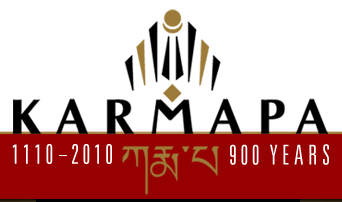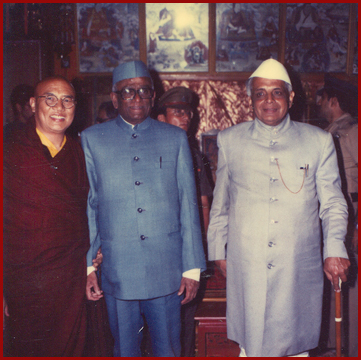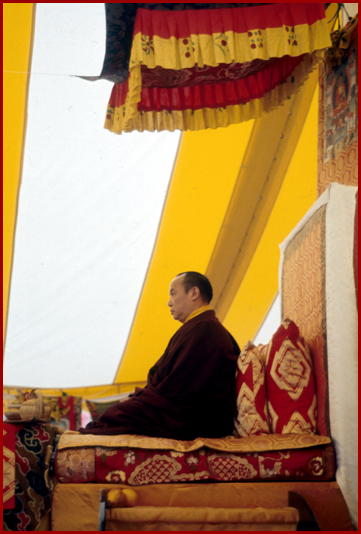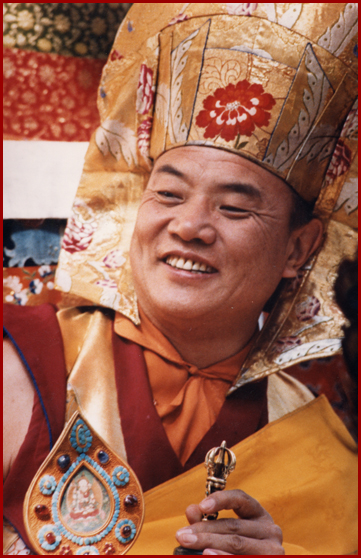The Sixteenth Karmapa shepherded his disciples and his lineage through the most traumatic upheaval that Tibetan Buddhism has faced since the time of the First Karmapa—the communist Chinese invasion of Tibet and flight to religious freedom south of the Himalayas. In exile, not only did His Holiness the Sixteenth Karmapa set the Karma Kagyu lineage on firm and stable ground in Buddhism’s ancient home of India; he further spread the Buddha’s teachings to the fertile soil he found farther afield, in Europe and America. Throughout, His Holiness displayed the skilful means and deep commitment to benefit others that is typical of the Karmapa line. The following offers a snapshot of the events of this great master’s life.
In Tibet
After his recognition as the Sixteenth in the reincarnation line founded by Dusum Khyenpa in the 11th century, the Gyalwang Karmapa travelled to Lhasa to meet His Holiness the Thirteenth Dalai Lama, who performed a formal hair-cutting ceremony for the Gyalwang Karmapa. During their first meeting, the Karmapa wore a black hat used for important ritual activities, known as an Action Crown. He removed the hat in order to perform the traditional prostrations to the Dalai Lama. When the Sixteenth Karmapa had completed his prostrations, His Holiness the Dalai Lama asked his chief minister why the Karmapa had not removed his second hat to prostrate. Astonished, the minister replied that the Gyalwang Karmapa had been completely bareheaded. When the Dalai Lama explained that the Karmapa had only removed the Action Crown, but not his other crown, all present realized that the Thirteenth Dalai Lama had been able to perceive the Naturally Appearing Wisdom Crown —known as the Black Crown—that all Karmapas bear, but only those of pure view actually perceive. In 1955, in his own next life, the Fourteenth Dalai Lama visited Tsurphu to receive the Black Crown Ceremony from the Sixteenth Karmapa.
From His Holiness the Karmapa’s words and deeds while in Tibet, it is clear that he had foreknowledge of the traumatic events to come. At the age of 17, he had composed a poem that included this verse, as translated in Michele Martin’s Music in the Sky:
Not now, but on a distant tomorrow it will be decided.
Both the vulture and I know where to go.
The vulture soars into the depths of space;
We people do not stay, but go to India.
In the springtime a cuckoo comes as a guest.
In the fall when the harvest ripens, it knows where to go.
Its only thought is travel to the east of India.
With remarkable prescience, he began preparing for the flight from Tibet long in advance. During the 15 years before the communist Chinese invasion of Tibet, His Holiness made repeated pilgrimages to India, Bhutan and Nepal, countries whose hospitality would ensure the future of Tibetan Buddhism and the Karma Kagyu lineage after Tibetans were forced into exile. While visiting Sikkim, he built on the historical ties between the Karma Kagyu and the Sikkimese royalty that date to the very inception of the Karma Kagyu.
Finding a Home in India
In 1959, after repeated petitions from his students to make his way to safety, His Holiness determined that the time had come to leave Tibet. Travelling overland for 21 days, the Gyalwang Karmapa and his party of 160 disciples arrived safely in Bhutan, where they were warmly received by the royal family. After discussions with the Government of India as to where it would be best to resettle, and following the eager invitation of the Sikkimese king, it was agreed that His Holiness would establish a base for his lineage in Sikkim. Given his choice of land in the kingdom, His Holiness selected a site in Rumtek where a previous Karmapa had founded a monastic establishment centuries earlier. That monastery had largely fallen into ruins, and was surrounded by dense jungle.
The Indian Prime Minister Jawaharlal Nehru generously offered the full support of the Indian government for the planned reconstruction. With land and further funds provided by the Sikkimese royal house, the daunting task of clearing jungle and creating a new monastic seat commenced in 1962. During the rebuilding effort, 108 monks and laypeople offered their service to the work 10 hours a day. By 1966, His Holiness had entered his new seat in Rumtek, called Dharmachakra Centre, and monastic life in exile could begin in earnest.
Turning to the West
Along with directing the re-establishment of Tibetan Buddhism in exile in India, a major deed of the Sixteenth Karmapa was his transmission of the Dharma to countries of the West. Throughout the 1960s and early 1970s, His Holiness made numerous Dharma connections with Western students who came to see him in India. He increasingly directed his energies towards the West in the mid-1970s, once his community was established at his seat in India, in Sikkim. His Holiness made a first tour of Western countries in 1974, visiting the United States, Canada and Europe. In 1975, he travelled to Rome to meet Pope Paul VI. On a subsequent and far lengthier tour from 1976 to 1977, the Gyalwang Karmapa met with other religious leaders, as well as important political and cultural figures.
As he travelled, His Holiness performed the Black Crown Ceremony on numerous occasions across the West, and conferred tantric initiation. Through these activities, His Holiness created strong Dharma connections with the large assemblies who gathered for these events. In private, His Holiness gave spiritual advice to the many students who sought his counsel, directly guiding the meditative practice of Western disciples. In this way, his activities both drew in new disciples seeking a spiritual path, and ripened the minds of those who were ready to commit themselves to serious Dharma practice. Wherever he went, through his mere presence and the teachings he gave with his every gesture, the Sixteenth Gyalwang Karmapa delivered the Dharma directly to the hearts and minds of all he met—in life and in his exceptional death.
The Final Stage
It is generally explained that the principal way that buddhas perform enlightened activity in the world is through speech—public discourses, verbal explanations and oral instructions. His Holiness certainly did teach in these ways, but one of the hallmarks of his teaching was his ability to create experiences for others not only with his speech, but with his body and mind as well. When the Sixteenth Karmapa neared the end of his life, he elected to pass away in America. As he did, he used his physical illness as a glorious and deeply transformative teaching for his Western disciples, as well as for the non-Buddhist medical staff who attended him.
The primary physician who attended His Holiness, Dr. Mitchell Levy, created a record of the medical events surrounding his passing away, seeking to make sense of the apparent discrepancies between what was scientifically possible and the empirical evidence that the entire medical staff was witness to. This remarkable report can be read online, and was earlier published in Reginald Ray’s Secret of the Vajra World. After apparently willing away death several times, His Holiness remained meditating in his hospital bed for three days even after he had been declared deceased by the physicians, as documented by the non-Buddhist medical staff present.
It was a mark of His Holiness’ wisdom and tremendous kindness toward his foreign disciples that he opted to display his death process in a hospital in Chicago, USA. In the case of masters as highly attained as the Karmapa, after their body apparently ceases functioning, there are often external signs indicating that they are still in a meditative state, controlling the transition to their next life. In Tibetan monasteries it is customary to permit people to view such masters as they sit in post-mortem meditation, their bodies still supple and fragrant. Seeing what serious spiritual practice makes possible greatly enhances viewers’ faith, and also demystifies the death process. In modern societies, death is generally dreaded and feared, and the possibility of understanding it as a positive opportunity seems out of the question. Yet during what would have been a debilitating and painful process for any ordinary person, His Holiness remained thoroughly focused on the doctors, nurses and visitors surrounding him and disinterested in the details of his own physical condition. Choosing to remain in the hospital to the end, the Gyalwang Karmapa’s warmth and joy were thrown into relief against the sterile clinical environment—vividly displaying the Buddhist truth that it is the mind that determines our experiences, and not our bodies or outer conditions. Enacting the Buddha’s teachings even with his final breath, the Sixteenth Gyalwang Karmapa was every bit as extraordinary in death as he was in life.






